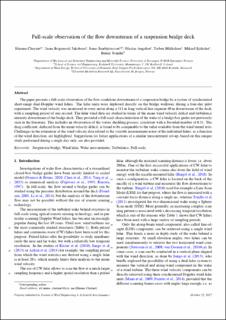| dc.contributor.author | Cheynet, Etienne | |
| dc.contributor.author | Jakobsen, Jasna Bogunovic | |
| dc.contributor.author | Snæbjörnsson, Jonas Thor | |
| dc.contributor.author | Angelou, Nikolas | |
| dc.contributor.author | Mikkelsen, Torben | |
| dc.contributor.author | Sjöholm, Mikael | |
| dc.contributor.author | Svardal, Benny | |
| dc.date.accessioned | 2020-04-17T09:26:49Z | |
| dc.date.available | 2020-04-17T09:26:49Z | |
| dc.date.created | 2017-10-23T10:02:17Z | |
| dc.date.issued | 2017-12 | |
| dc.identifier.citation | Cheynet, E., Jakobsen, J.B., Snæbjörnsson, J. et al. (2017). Journal of Wind Engineering and Industrial Aerodynamics, 171, 261-272. | en_US |
| dc.identifier.issn | 0167-6105 | |
| dc.identifier.uri | https://hdl.handle.net/11250/2651474 | |
| dc.description.abstract | The paper presents a full-scale observation of the flow conditions downstream of a suspension bridge by a system of synchronized short-range dual-Doppler wind lidars. The lidar units were deployed directly on the bridge walkway during a four-day pilot experiment. The wind velocity was monitored at every meter along a 111 m long vertical line segment 40 m downstream of the deck, with a sampling period of one second. The lidar wind data are studied in terms of the mean wind velocity deficit and turbulence intensity downstream of the bridge deck. They provided a full-scale characterization of the wake of a bridge box girder not previously seen in the literature. This includes an observation of the vortex shedding process, consistent with a Strouhal number of 0.11. The drag coefficient, deduced from the mean velocity deficit, is found to be comparable to the value available from the wind tunnel tests. Challenges in the estimation of the wind velocity data related to the variable measurement noise of the individual lidars, as a function of the wind direction, are highlighted. Suggestions for future applications of a similar measurement set-up, based on this unique study performed during a single day only, are also provided. | en_US |
| dc.language.iso | eng | en_US |
| dc.publisher | Elsevier Ltd. | en_US |
| dc.rights | Attribution-NonCommercial-NoDerivatives 4.0 Internasjonal | * |
| dc.rights.uri | http://creativecommons.org/licenses/by-nc-nd/4.0/deed.no | * |
| dc.subject | suspension bridge | en_US |
| dc.subject | wind lidar | en_US |
| dc.subject | hengebro | en_US |
| dc.subject | wake measurement | en_US |
| dc.subject | turbulence | en_US |
| dc.subject | full-scale | en_US |
| dc.title | Full-scale observation of the flow downstream of a suspension bridge deck | en_US |
| dc.type | Peer reviewed | en_US |
| dc.type | Journal article | en_US |
| dc.description.version | acceptedVersion | en_US |
| dc.rights.holder | © 2017 Elsevier Ltd. All rights reserved. | en_US |
| dc.subject.nsi | VDP::Teknologi: 500 | en_US |
| dc.source.pagenumber | 261-272 | en_US |
| dc.source.volume | 171 | en_US |
| dc.source.journal | Journal of Wind Engineering and Industrial Aerodynamics | en_US |
| dc.identifier.doi | 10.1016/j.jweia.2017.10.007 | |
| dc.identifier.cristin | 1506665 | |
| cristin.unitcode | 217,8,5,0 | |
| cristin.unitname | Institutt for maskin, bygg og materialteknologi | |
| cristin.ispublished | true | |
| cristin.fulltext | postprint | |
| cristin.qualitycode | 1 | |

